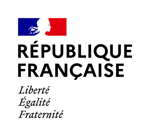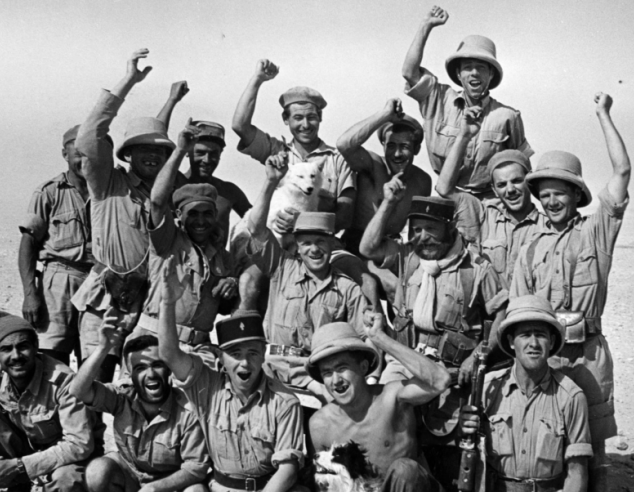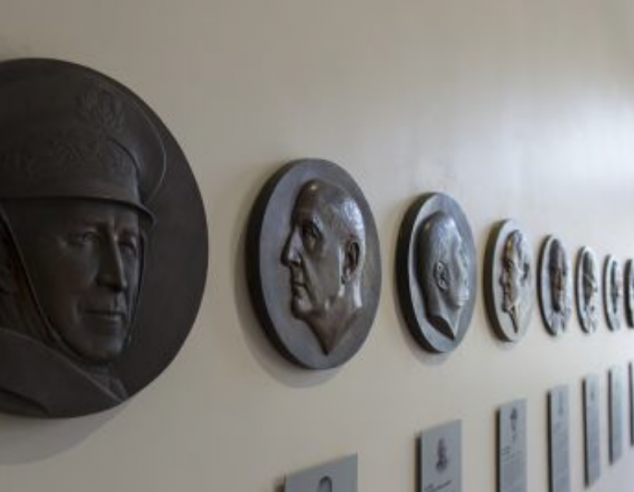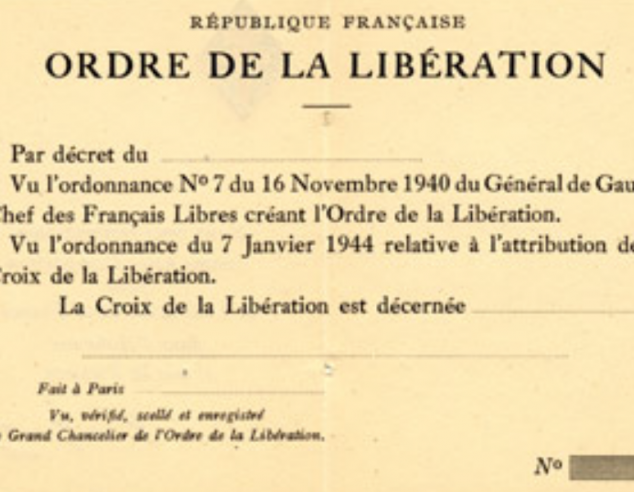The Order of the Liberation and its evolution
The Order of the Liberation has evolved since its creation on November 16, 1940. Today, it is a national public administrative establishment placed under the authority of the Ministry of the Armed Forces. The Law of July 13, 2018 relating to military planning expanded the Board of Directors and conferred a new task to the Order of the Liberation: to develop the spirit of defense through the history of the Companions and French Resistance Medal recipients.
 Conseil de l’Ordre à Paris le 26 octobre 1944. De gauche à droite : Guy Baucheron de Boissoudy, François Ingold, René Pleven, l’amiral d’Argenlieu, Pierre Koenig, Geoffroy Chodron de Courcel, Claude Hettier de Boislambert et André Postel-Vinay
Conseil de l’Ordre à Paris le 26 octobre 1944. De gauche à droite : Guy Baucheron de Boissoudy, François Ingold, René Pleven, l’amiral d’Argenlieu, Pierre Koenig, Geoffroy Chodron de Courcel, Claude Hettier de Boislambert et André Postel-Vinay
Creation:
On January 29, 1941, General de Gaulle appointed the first Companions by decree, who also became the first members of the Council of the Order of the Liberation under the authority of the first chancellor, Georges Thierry d'Argenlieu. The other members of the Council were Governor Félix Eboué, Lieutenant Emmanuel d'Harcourt, Merchant Navy Officer Edmond Popieul, and Warrant Officer of the Free French Air Forces Henry Bouquillard.
Original role:
Originally, the role of the Council consisted of studying nominations for admission to the Order and giving opinions which would then be submitted to General de Gaulle to be signed. General de Gaulle was the only person who could appoint Companions of the Liberation.
The Council was required to meet once every three months, “military operations permitting”, to deliberate the proposals it received. The Council was not sedentary; its members were dispersed according to their civil and military duties. As such, Governor Eboué lived in Brazzaville and Thierry d’Argenlieu fulfilled a number of diplomatic missions (particularly in Canada), while d’Harcourt, Popieul and Bouquillard were tasked respectively with sea and air missions in France.
The Council would also hold special meetings with the leader of the Free French to review urgent proposal requests.
During these meetings, the files of nominated military personnel and civilians were studied. Generally speaking, a proposal memorandum, which worked its way up the chain of command to the Council of the Order, was prepared by commanding officers (for Free French) or by network leaders (for French Resistance fighters).
Its role after the war:
After foreclosure of the Order on January 23, 1946, the Council of the Order was tasked with extending and maintaining the traditions and ideals held by General de Gaulle as well as ensuring the rigor of the Order. The Council of the Order has evolved since its creation when it had just five board members. There is no legislation in place confirming the number of members to be reached. However, members of the Council – who must be Companions of the Liberation – are appointed by decree.
The Order of the Liberation seemed destined to come to a natural end with the last living Companions of the Liberation. However, as the Order of the Liberation is the second national Order in France which embodies the values of the French Resistance and the Liberation, and which also covers several missions concerning remembrance (organization of ceremonies on June 18 in Mont-Valérien and on November 9 in Colombey-les-Deux-Eglises) and society (support for the families of Companions and medal recipients), it therefore seemed necessary to secure its future.
Among the Companions of the Liberation, the only ones that will live on indefinitely are the five French municipalities, recipients of the Cross of Liberation (Nantes, Grenoble, Paris, Vassieux-en-Vercors and l'Ile de Sein). As such, it seemed logical to turn the focus to the municipalities in order to ensure continuity of the Order of the Liberation.
Go to page: Companions of the Liberation
This is why, on May 26, 1999, Law no. 99-418 created the National Council of “Companions of the Liberation” Municipalities, a national public administrative establishment. (Journal Officiel de la République Française, May 28, 1999). It was unanimously adopted by the French National Assembly and Senate. This Council replaces the Council of the Order of the Liberation, which ensured the institution’s operation alongside the Chancellor from the date the Order of the Liberation was created.
As such, the Council was tasked with:
- Ensuring the traditions of the Order of the Liberation
- Keeping its memory alive
- Managing the Museum of the Order of the Liberation
Organizing ceremonies commemorating the Appeal of June 18 and the death of General de Gaulle.
Taking part in the provision of material and moral support for Companions of the Liberation, French Resistance Medal recipients, and their families.
Running the French Resistance Medal service.
It was composed of the mayors in office across the five municipalities, Companions of the Liberation, and a National Delegate; appointed over a renewable four-year term by decree of the President of the Republic.
 Conseil d’administration du 29 novembre 2018.
Conseil d’administration du 29 novembre 2018.
On the wishes of the Companions and the French authorities, the Order of the Liberation must endure by becoming a guiding light for citizenship, especially among the country’s youngest citizens. A nation shaped by exemplary lives, the histories and commitments of the Companions and French Resistance Medal recipients must continue to inspire our fellow citizens in order to develop and strengthen the vital spirit of defense that should drive the nation.
Under the supervision of the Ministry of the Armed Forces as of April 2017, the Order of the Liberation is a public administrative establishment led by a National Delegate, Christian Baptiste, général de division (2S), appointed by the presidential decree of January 9, 2017. An honorary chancellor was also appointed by the President. As of October 23, 2017, Companion of the Liberation, Daniel Cordier, holds the role.
The Law of July 13, 2018 relating to military planning propelled the Order into the future by conferring on it a new mission to develop the spirit of defense through the commitments of the Companions of the Liberation and French Resistance Medal recipients.
Changes to the composition of the Board of Directors have been enacted within this context. Co-chairing of the Board of Directors is ensured by the National Delegate, as well as by each of the five mayors of the “Companion of the Liberation” municipalities, on a rotating basis, for a calendar year.
The Board of Directors is composed of:
- physical individuals awarded the Cross of Liberation;
- mayors of the five “Companion of the Liberation” municipalities or their representatives;
- Secretary-General for Administration of the Ministry of the Armed Forces or their representative;
- Chief of Staff of the French Army or their representative;
- Chief of Staff of the French Air Force or their representative;
- Chief of Staff of the French Navy or their representative;
- Chair of the Scientific Council of the Museum of the Order of Liberation;
- President of the Association des familles de Compagnon de la Libération or their representative;
- President of the Association des Amis du Musée or their representative;
- President of the national association of French Resistance Medal recipients (ANCMRF) or their representative.
















